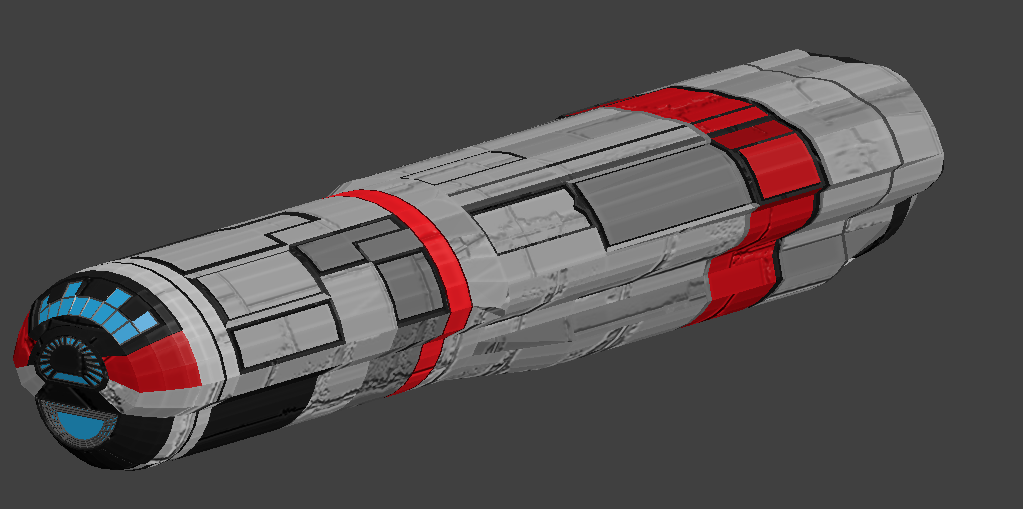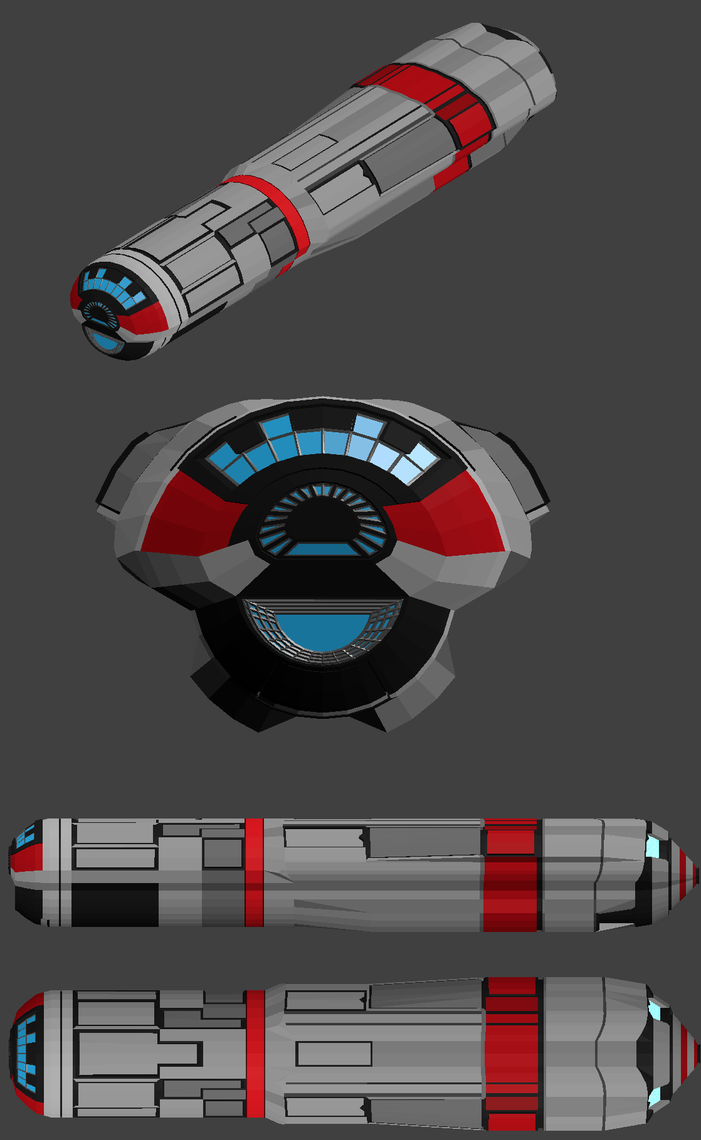Here we see an example of the Survey Corvette after the new ship smell has worn off.
The Rough Country is an independent operations version of the 500 ton Survey/exploration Corvette. Designed for exploration/survey/and Scientific assistance operations on it's own without A heavier Explorer vessel supporting it.
Assigned to Scout Services, Perimeter Exploration and Survey Group 227. the Rough Country has experienced it's share of impacts, attacks, and brutal planetary conditions. Her hull is scarred. Her paint is fading. And her systems have been pushed to the limits of the crews ability to maintain them. But the rough country takes a licking and Keeps on ticking. four years overdue for refit, and refurbishment, the Rough Country wears her scars as a badge of honor.
I wanted to show off my first successful attempt at applying bump maps and speculars to a models. This old girl is now my pride and joy. I as able to show wear and tear, and fading on her hull plate and seams. I am a happy camper, i finally licked the one issue that was driving me absolutely bananas.

Clean Simple texture version

The 500 ton survey vessel is a modular hull fitted with large bays to hold laboratories, sensor arrays, drone launch and recovery facilities, and remote operated vessels. It lacks armor and weapons due to the its use as a first contact/survey vessel. It however is usually accompanied by a larger Explorer vessel which carries combat small craft and it's own weaponry. With the bulk of its space designated for internal scientific facilities, and housing for assigned crew and specialists. The vessel is known to be rather roomy and comfortable to serve on.
When configured for survey operations the vessel carries a wide variety of sensors, deployable sensor arrays, and large numbers of drones, and remote operated vehicles. In addition the survey vessel has the ability to land, take local samples, and operate as a mobile survey station. to carry out this mission it is also fitted with storage bays for vehicles, and cargo pallet to store hardware, supplies and instruments for use by the ground team.
for safety the vessel has a high degree of agility, radiation, and heat shielding, as well as a high acceleration rate to allow it to avoid attack, and retreat to the protection of armed vessels accompanying it. In extreme cases it will carry fighter drones, and turret drones in its storage hangers instead of utility craft. In addition all survey cutters are equipped with full medical bays,surgical theater, and two specially fitted quarantine rooms.
The Survey Cutter has large drives, and it's own jump dries, however it's jump drives are short ranged systems useful for emergency jumps, and short range operations to systems neighboring the current location of the Corvettes explorer vessel. Its acceleration is high for a non military craft, allowing it to quickly re-position, and evade hostile vessels. In addition it has surplus power generation capabilities allowing it to maneuver, power it's jump drives, and maintain sensor operations.
LAYOUT:
the vessel has an obvious number of large observation windows and domes on its forward section. Usually these cover observatory packages, labs, sensor packages. they are heavily reinforced to survive impacts from debris. The observations areas can also be fitted as recreational areas when not needed for survey, observation hardware. if used for first contact, or diplomatic functions, often the observations areas are refitted as reception and conference areas.
The bridge of the ship is completely enclosed, and near the core of the ship, along with vital systems for power, life support, and jump drives. Labs and utility bays are arranged around the core systems, and often have small direct access to one another avoiding the core areas when possible to provide the scientific crew to move about without interfering with the ships crew. In addition, internal bulkheads, and secure hatches to control spread of contaminants, biological threats, and fire during accidents.
a large bay is fitted under the nose of the ship, allowing up to a 50 ton smallcraft bay, or a 50 ton cargo pallet additional bays on the secondary engine wells allow the craft to attach high energy demand systems, or additional fuel cells, close to the ships power systems. This does include weapons pallets if the need arises, but is seldom used to maintain the non-combat nature of Survey cutters.
multiple modular bays, and hangers are arranged along the sides of the vessel, and hardpoints for attaching drop tanks, cargo modules, and other external pallets if needed.
Statistics: exact details forthcoming when Mongoose high Guard revision complete.
Thrust: 4
Jump: 1( 3 for independent operations versions)
Fuel: 2 months,+single jump 1 fuel ( fuel scoops and processors installed)
Power systems: fusion reactor, with additional solar cells on external hull.
Crew: varies
Nomral ship crew consist of
2 pilots
Navigator
2 Sensor, system operator
4 engineers
2 medical officers
1 Steward/science team liaison Officer
4 security Officer/marines
advanced sensors, survey sensor array, and deployable array.
Small craft 3 ten ton survey ROVs
2 10 ton modules for housing
2 50 ton modular bays
20 robotic Survey drones
The Rough Country is an independent operations version of the 500 ton Survey/exploration Corvette. Designed for exploration/survey/and Scientific assistance operations on it's own without A heavier Explorer vessel supporting it.
Assigned to Scout Services, Perimeter Exploration and Survey Group 227. the Rough Country has experienced it's share of impacts, attacks, and brutal planetary conditions. Her hull is scarred. Her paint is fading. And her systems have been pushed to the limits of the crews ability to maintain them. But the rough country takes a licking and Keeps on ticking. four years overdue for refit, and refurbishment, the Rough Country wears her scars as a badge of honor.
I wanted to show off my first successful attempt at applying bump maps and speculars to a models. This old girl is now my pride and joy. I as able to show wear and tear, and fading on her hull plate and seams. I am a happy camper, i finally licked the one issue that was driving me absolutely bananas.

Clean Simple texture version

The 500 ton survey vessel is a modular hull fitted with large bays to hold laboratories, sensor arrays, drone launch and recovery facilities, and remote operated vessels. It lacks armor and weapons due to the its use as a first contact/survey vessel. It however is usually accompanied by a larger Explorer vessel which carries combat small craft and it's own weaponry. With the bulk of its space designated for internal scientific facilities, and housing for assigned crew and specialists. The vessel is known to be rather roomy and comfortable to serve on.
When configured for survey operations the vessel carries a wide variety of sensors, deployable sensor arrays, and large numbers of drones, and remote operated vehicles. In addition the survey vessel has the ability to land, take local samples, and operate as a mobile survey station. to carry out this mission it is also fitted with storage bays for vehicles, and cargo pallet to store hardware, supplies and instruments for use by the ground team.
for safety the vessel has a high degree of agility, radiation, and heat shielding, as well as a high acceleration rate to allow it to avoid attack, and retreat to the protection of armed vessels accompanying it. In extreme cases it will carry fighter drones, and turret drones in its storage hangers instead of utility craft. In addition all survey cutters are equipped with full medical bays,surgical theater, and two specially fitted quarantine rooms.
The Survey Cutter has large drives, and it's own jump dries, however it's jump drives are short ranged systems useful for emergency jumps, and short range operations to systems neighboring the current location of the Corvettes explorer vessel. Its acceleration is high for a non military craft, allowing it to quickly re-position, and evade hostile vessels. In addition it has surplus power generation capabilities allowing it to maneuver, power it's jump drives, and maintain sensor operations.
LAYOUT:
the vessel has an obvious number of large observation windows and domes on its forward section. Usually these cover observatory packages, labs, sensor packages. they are heavily reinforced to survive impacts from debris. The observations areas can also be fitted as recreational areas when not needed for survey, observation hardware. if used for first contact, or diplomatic functions, often the observations areas are refitted as reception and conference areas.
The bridge of the ship is completely enclosed, and near the core of the ship, along with vital systems for power, life support, and jump drives. Labs and utility bays are arranged around the core systems, and often have small direct access to one another avoiding the core areas when possible to provide the scientific crew to move about without interfering with the ships crew. In addition, internal bulkheads, and secure hatches to control spread of contaminants, biological threats, and fire during accidents.
a large bay is fitted under the nose of the ship, allowing up to a 50 ton smallcraft bay, or a 50 ton cargo pallet additional bays on the secondary engine wells allow the craft to attach high energy demand systems, or additional fuel cells, close to the ships power systems. This does include weapons pallets if the need arises, but is seldom used to maintain the non-combat nature of Survey cutters.
multiple modular bays, and hangers are arranged along the sides of the vessel, and hardpoints for attaching drop tanks, cargo modules, and other external pallets if needed.
Statistics: exact details forthcoming when Mongoose high Guard revision complete.
Thrust: 4
Jump: 1( 3 for independent operations versions)
Fuel: 2 months,+single jump 1 fuel ( fuel scoops and processors installed)
Power systems: fusion reactor, with additional solar cells on external hull.
Crew: varies
Nomral ship crew consist of
2 pilots
Navigator
2 Sensor, system operator
4 engineers
2 medical officers
1 Steward/science team liaison Officer
4 security Officer/marines
advanced sensors, survey sensor array, and deployable array.
Small craft 3 ten ton survey ROVs
2 10 ton modules for housing
2 50 ton modular bays
20 robotic Survey drones
